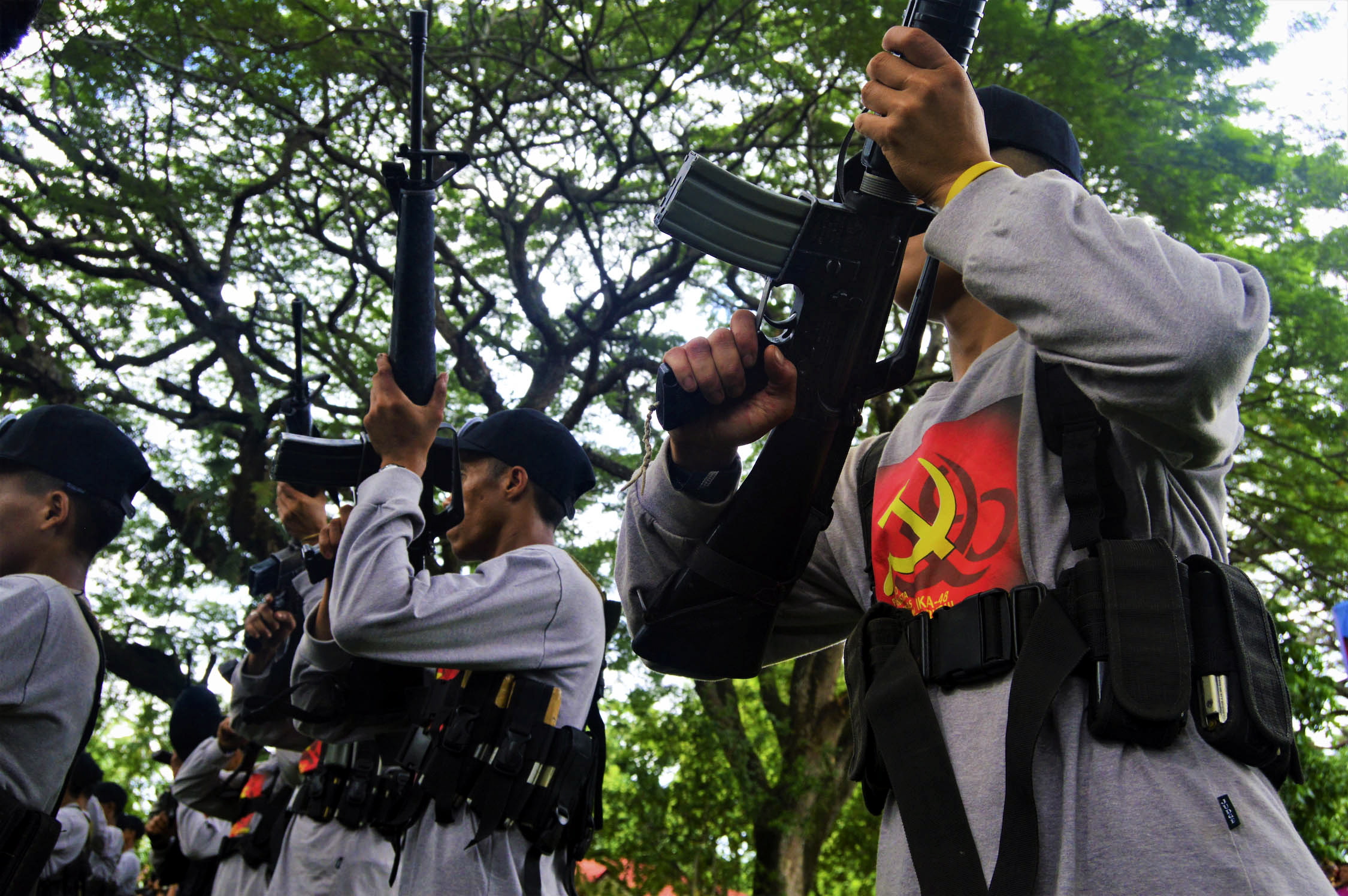
(FILE) Young New Peoples Army (NPA) rebels stand in formation during the recent anniversary of the Communist Party of the Philippines (CPP) in a town in Misamis Oriental province on Dec. 26, 2016. (Jigger J. Jerusalem)
MANILA, Philippines–A Manila court has dismissed the government’s petition to declare the Communist Party of the Philippines (CPP) and its armed wing, the New People’s Army (NPA), as a terrorist organization.
The government filed the proscription petition through the Department of Justice (DOJ) in 2018 based on Section 17 of Republic Act 9372 or the Human Security Act of 2007. If granted, it hoped to seek clearance from the Court of Appeals for wiretapping, freezing, and viewing bank accounts of CPP-NPA leaders and members.
With the Anti-Terrorism Act (ATA) of 2020, the HSA is repealed. The ATA tagged six CPP leaders as terrorists.
READ: PH terror council tags 6 Reds, 5 others as terrorists
In denying the government’s case, Manila Regional Trial Court Presiding Judge Marlo Magdoza-Malgar said the CPP-NPA was not organized for terrorism.
“While the armed struggle with the violence that necessarily accompanies it is indubitably the approved means to achieve the CPP-NPA’s purpose, means is not synonymous with purpose. Stated otherwise, armed struggle is only a means to achieve the CPP’s purpose; it is not the purpose of the creation of the CPP,” part of the court’s 135-page ruling said.
CPP’s 10-point plans of action, the court said, “are reasonable aspirations of any civilized society.”
Included in the 10-point program are the following:
– Fight for national unity and democratic rights
– upholding the principle of democratic centralism,
– solving the land problem,
– carrying out national industrialization,
– promoting national scientific and mass culture,
– respecting the right to self-determination of the Bangsamoro and other national minorities and adopting an active and independent foreign policy.
A reminder that communist groups should be called terrorists, the DOJ pointed out atrocities the CPP-NPA allegedly committed.
Of the incidents mentioned, the court has confined the scope of its assessment to nine incidents, including the following:
– the December 31, 2019, killing of Bontola Mansinugdan in Agusan del Sur;
– killings in 2019 and three separate 2020 killings in Surigao del Sur;
– the May 2020 burning of a chapel and residential houses in Misamis Oriental and
– the July 2020 killing of Datu Saidor Balansi in Cagayan de Oro City.
The government witnesses identified the perpetrators as NPA members based on their clothing, an all-black ensemble, and firearms.
“Certainly, it takes more than a certain manner or mode of dressing to establish that one is a member of the CPP-NPA,” the court said adding that unless there is evidence to show that an all-black ensemble is the official uniform of the CPP-NPA, it cannot consider the witnesses’ identification.
In terms of firearms, the court said the nine incidents occurred in Mindanao, “teeming with armed rebel groups–the MNLF, MILF, Abu Sayyaf, Maute Group and a scattering of brigands who may also be known to carry firearms.”
The court said the nine incidents were confined to particular places in Mindanao.
“Any fear and panic these incidents may have caused are confined to the communities where they have occurred,” the court said adding that it has not reached the “widespread and “extraordinary” proportions contemplated under the law.
“Perhaps contributing to the low impact of the foregoing atrocities is the CPP-NPA’s chosen battle strategy which is guerrilla warfare within the context of a protracted people’s war,” it said, adding that “the nine incidents of atrocities fall within the category of small-time “hit and run” attacks and sporadic acts of violence with no specified victims or targets.”
The court said the government could also not present evidence to prove that the nine incidents in Mindanao were committed on the orders of the communist leadership.
It added that the government has also failed to establish that the nine incidents were committed to coerce the government to give in to demand.
“Even if one assumes that these incidents have managed to hold the government’s attention, the petitioner’s evidence has yet to establish that these incidents were meant to coerce the government to give in to the perpetrator’s demand. More particularly, it remains to be shown that immediately prior to, contemporaneous with or immediately after, the commission of the “terrorist acts” the CPP or the NPA has made any “demand” to the government,” the court said.
It added that the government failed to support its argument that the attacks were meant to force the government to engage in peace talks to prevent more bloodshed.
“Even if such demand is assumed to be an implicit motive of these disparate incidents, still, it can hardly be said that a demand for peace negotiation is an unlawful demand.A demand for peace negotiation or peace talk or cessation of hostilities, is on its face, a valid lawful demand,” the court added.
The court said only one of the incidents cited by the government closely fits as a “terrorist attack” is the Plaza Miranda bombing in 1971. But it happened before the HSA, so it couldn’t be used against CPP-NPA.
“Classifying these acts as “terrorist acts” that will in turn classify the CPP-NPA as terrorist organization would lead the Court to tread on the constitutionally-infirm ground- that of applying provisions of a penal law to acts committed prior to the law’s enactment,” the court said.
Initially, 600 names were in the government’s proscription petition but the plea was amended several times until the names were trimmed down to less than 20.
RELATED STORIES:
ATC ‘designates’ CPP-NPA as terrorist organizations
600 ‘terrorists’ stricken off revised DOJ petition vs Reds
Court orders DOJ to summon Joma Sison over CPP-NPA case

